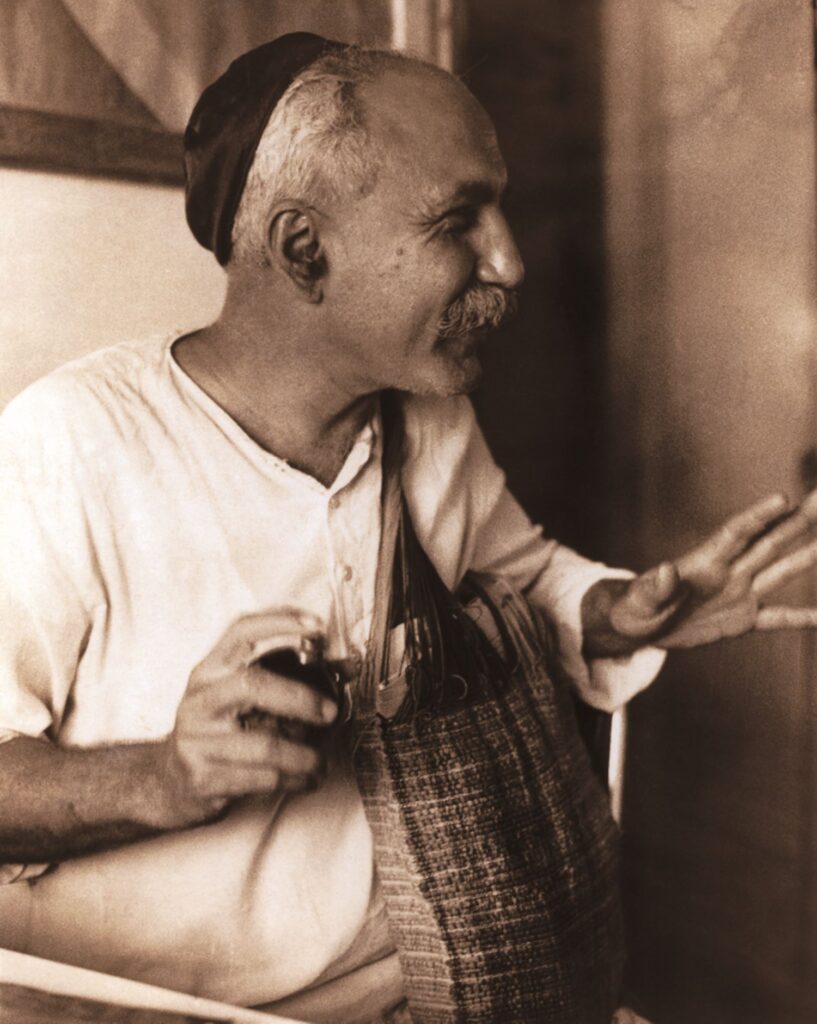
Have you ever heard of an architect who worked without an office and rarely made detailed drawings for his building projects? It may seem strange, but there was one such architect named Nari Gandhi. He was an Indian architect known for his very innovative building designs inspired by the great architect Frank Lloyd Wright, with whom Nari apprenticed for five years in Wright’s studio at Taliesin, USA.
About his way of working, Nari Gandhi once said, “All art must be spontaneous and cannot be planned … A house grows organically. I need heart and mind to build, not a static blueprint.”
Nariman (Nari) Dossabhai Gandhi (January 2, 1934 – August 18, 1993) was born in Surat to a Parsi family but grew up in Mumbai, where his parents lived. Nari Gandhi did his schooling at St. Xavier’s High School in Fort, Mumbai. After that, he studied architecture at the Sir J.J. School of Art until 1956. In college, he met Rustom Patel and Mansinh Rana, the two students of Frank Lloyd Wright. It is said that Mansinh Rana recommended Nari Gandhi leave the Sir JJ School of Art to join Frank Lloyd Wright’s famed architectural school and studio at Taliesin West in Arizona, USA, to further his architecture education. Nari studied and worked at Taliesin from October 1956 to December 1961, during which time Frank Lloyd Wright passed away in April 1959.
Nari Gandhi’s time working with Frank Lloyd Wright at Taliesin was extremely important in shaping his architectural philosophy and career path. At Taliesin, Gandhi was immersed in Wright’s vision of architecture and surrounded by like-minded people. He could learn Wright’s teachings directly and gain practical experience. At Taliesin, Gandhi learned about Wright’s principles of organic architecture, which emphasize harmony between buildings and the natural environment around them.
Nari Gandhi learned Wright’s innovative design techniques and organic architecture philosophies. Beyond just theory, Gandhi got hands-on experience working on various projects under Wright’s guidance. This practical education was invaluable for developing Gandhi’s architectural skills and creativity. Gandhi’s association with Wright and time at Taliesin had a lasting impact on his later architectural work.
After leaving Taliesin in December 1961, Nari Gandhi joined Kent State University in Ohio, USA, where he studied pottery, ceramics, woodcarving, and weaving.

From the USA to India
After returning from the USA, Nari Gandhi started his professional architecture career in India, bringing the influences and lessons he learned from Frank Lloyd Wright. Gandhi’s start and path in Indian architecture blended modernist principles, organic design sensibilities, and a deep appreciation for India’s cultural heritage.
When he returned, Gandhi established his architecture practice in Mumbai, India, where he began making a name for himself with innovative designs and a unique approach. His projects showcased his willingness to experiment with different materials, forms, and spatial arrangements.
Gandhi’s architecture philosophy believed that buildings should respond to their context, both cultural and environmental. He aimed to create buildings that harmonized with their surroundings, integrating smoothly into the landscape while also meeting the functional needs of the people using them.
Throughout his career, Gandhi promoted using indigenous building materials and techniques, advocating for local materials like stone, brick, mud, wood, bamboo and thatch in his projects. He believed this approach helped create environment-friendly buildings that also celebrated India’s rich architectural traditions.
Concepts and Design Philosophy
Nari Gandhi’s philosophy combined modern principles with traditional Indian influences. He believed buildings should blend naturally with their surroundings and the environment. He was inspired by Frank Lloyd Wright’s organic architecture ideas. Gandhi’s designs often had flowing, geometrical shapes that mirrored the landscape to unite the built and natural environments.
Gandhi felt architecture must respond to the cultural, historical, and environmental context of each project site. He drew inspiration from India’s diverse architectural heritage while using modern materials and techniques. His designs included elements like courtyards, verandas, and local materials to create a sense of place.
Sustainability was very important to Gandhi before it became mainstream. He advocated using eco-friendly, indigenous building materials and methods relevant to local culture. Energy efficiency, natural ventilation, and passive solar principles were prioritized to reduce environmental impact while providing healthy, comfortable spaces.
Gandhi was experimental and innovative, pushing boundaries with unconventional shapes, materials, and construction systems. His avant-garde designs challenged traditional notions of what buildings could be.
Central to his philosophy was human-centred design focused on meeting the needs and aspirations of occupants. Creating functional yet inspiring spaces that fostered connection and belonging within the built environment was key.
Significant Works
Some of Gandhi’s notable works from 1964-1993 that embodied his philosophies include the Rustam Mehta Residence, Daya’s Madh Island House, Jain Bungalow, Jal Gobhai’s Mountain Lodge, and Sadruddin Daya’s Revdanda Residence. His influence shaped Indian architectural discourse and inspired generations of architects.
Rustom Mehta’s Residence in Korlai, Maharashtra
Rustom Mehta’s residence in Korlai, Maharashtra, is one of Nari Gandhi’s notable architectural projects. Located in a coastal village in the Raigad district of Maharashtra, India, this residence exemplifies Gandhi’s commitment to blending modernist design principles with traditional Indian influences, all while responding to the unique context of its surroundings.
The design of Rustom Mehta’s residence reflects Gandhi’s organic architectural philosophy, which emphasizes harmony between buildings and their natural environment. Situated along the scenic coastline, the residence takes advantage of its picturesque surroundings, offering panoramic views of the Arabian Sea and the rugged landscape.
One of the distinctive features of the residence is its integration with the natural topography of the site. Gandhi’s design responds sensitively to the sloping terrain, with the building’s form following the contours of the land. This seamless integration with the landscape creates a sense of unity between the built environment and the surrounding natural elements.
The design of this sea-facing house is like an elevated open-arched pavilion. The lower level of the house accommodates bedrooms, a kitchen, and services whereas the upper level houses a living area which affords spectacular views of the sea. Constructed in wire-cut hollow bricks, the building incorporates features like large arches, buttresses and Mangalore-tiled slanting roof. Jutting out trees from the house creates an interesting composition and makes the building blend with nature.
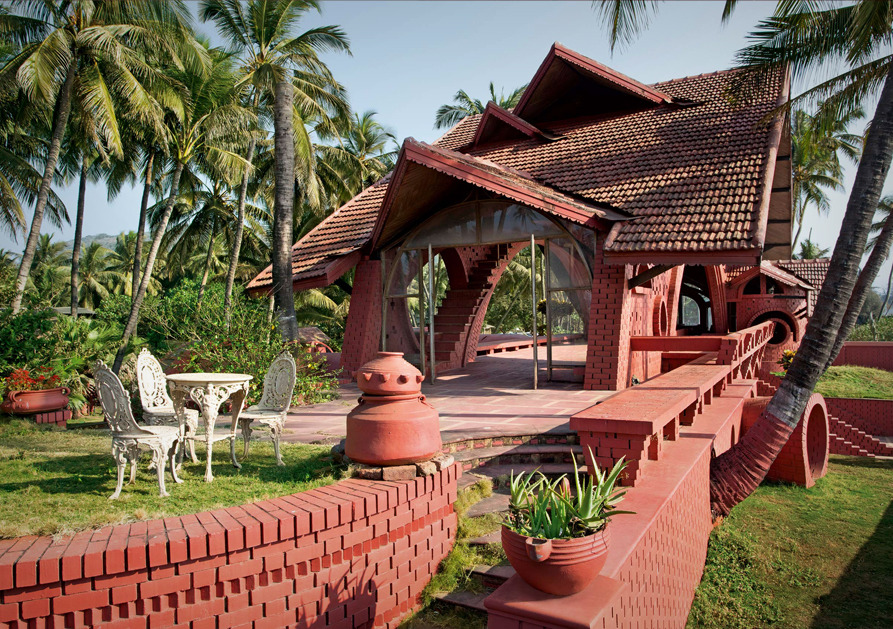

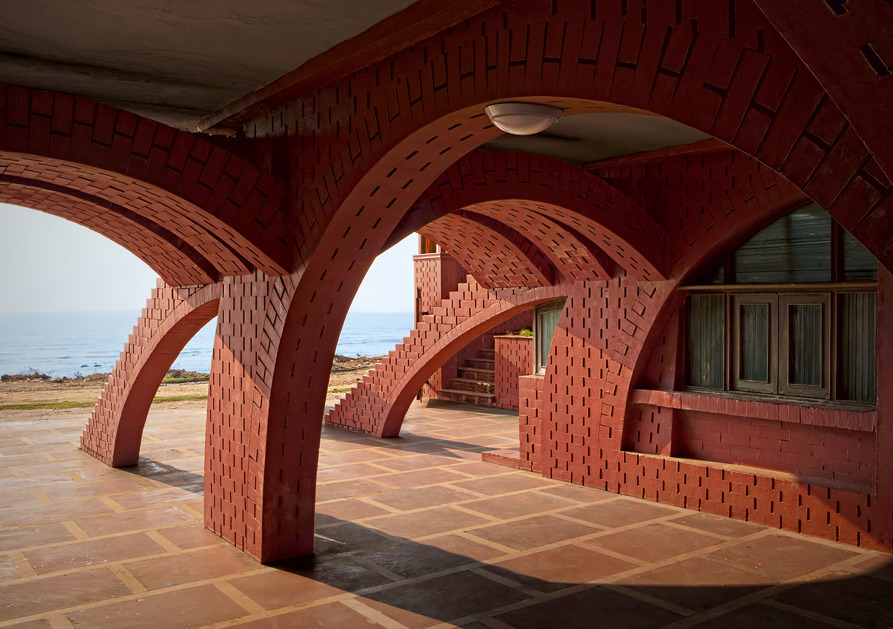
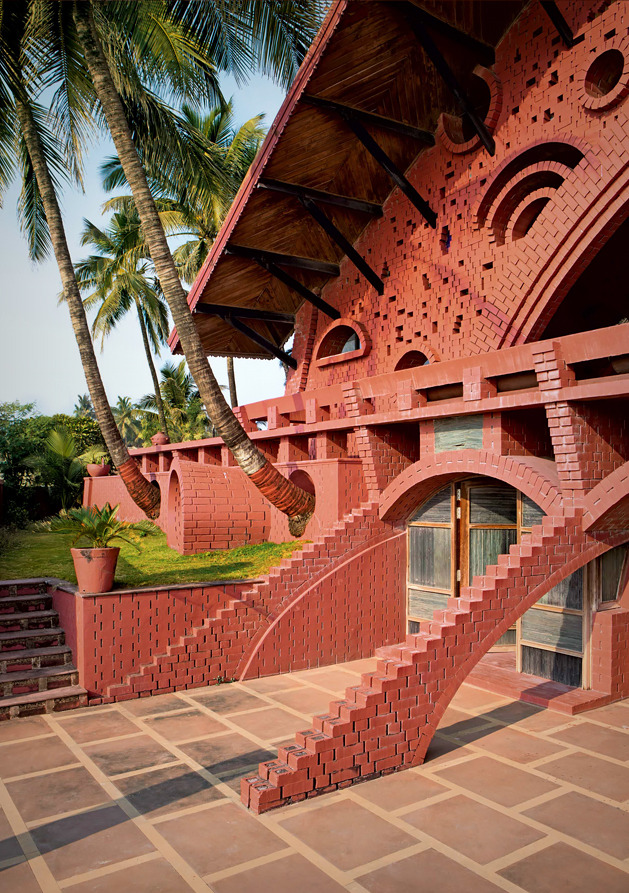
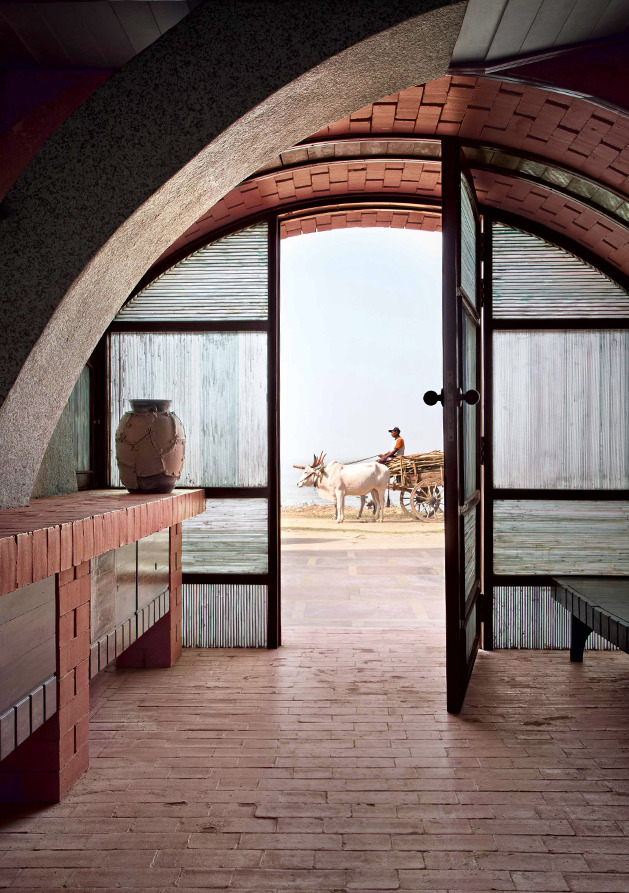
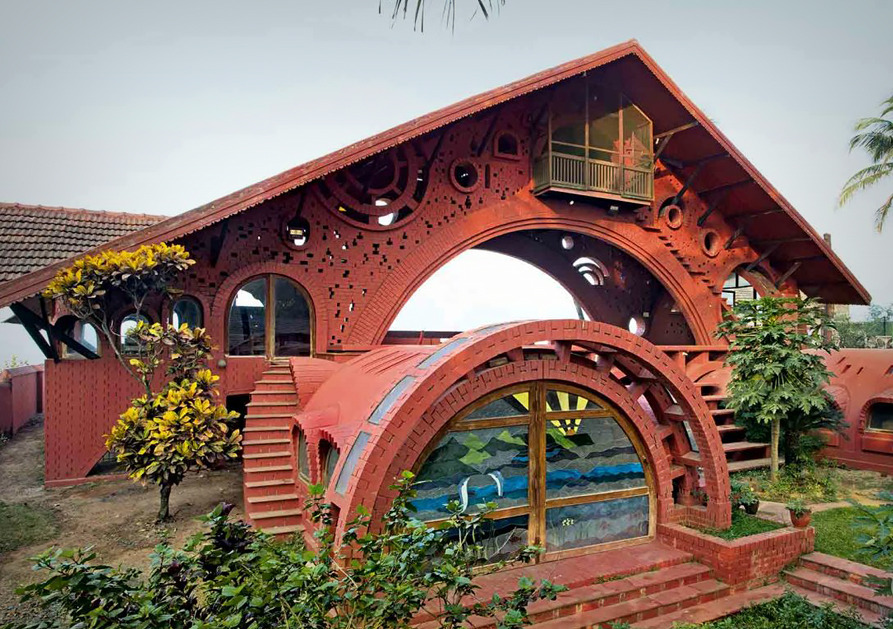
Daya’s Madh Island House
Nari Gandhi’s project, Daya’s Madh Island House, is another significant architectural endeavour that showcases his innovative design approach and sensitivity to the natural environment. Located on Madh Island, a coastal area near Mumbai, Maharashtra, this residential project reflects Gandhi’s commitment to organic architecture while responding to the specific context of the site.
The house is located on a narrow plot. Nari Gandhi created three vaults on the site and filled their external shells with earth to convert their crowns into a continuous mass of garden. The roof was thus a traversable garden, roughly the same size as the house and had punctures all over that were sometimes capped with glass domes to throw light in the space below. The house is completely camouflaged in the already dense palm plantation on the site. Nari Gandhi planted more species of plants to create an ever-denser environment.
The terrace garden of the house has a vaulted canopy made from nylon strings and mother-of-pearl shells. Stonework in the exterior garden and punctures showcases Nari Gandhi’s exceptional skills acquired while working with Frank Lloyd Wright at Taliesin. Stones were broken into small chips and clad onto surfaces coated with cement. Ceramic sculptures of human faces were introduced in this stonework to add grandeur to the environment.
Beyond its architectural merit, Daya’s Madh Island House is a testament to Gandhi’s ability to create spaces that are not only functional but also deeply rooted in their cultural and natural context. By embracing the unique qualities of the site and integrating them into the design, Gandhi has crafted a residence that celebrates the beauty of its surroundings while providing a serene and harmonious retreat for its occupants.


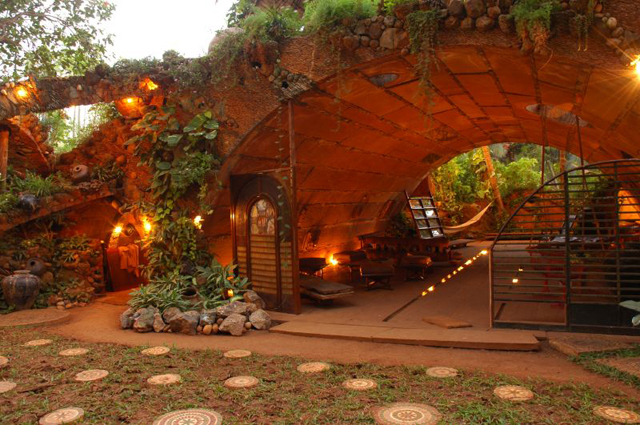
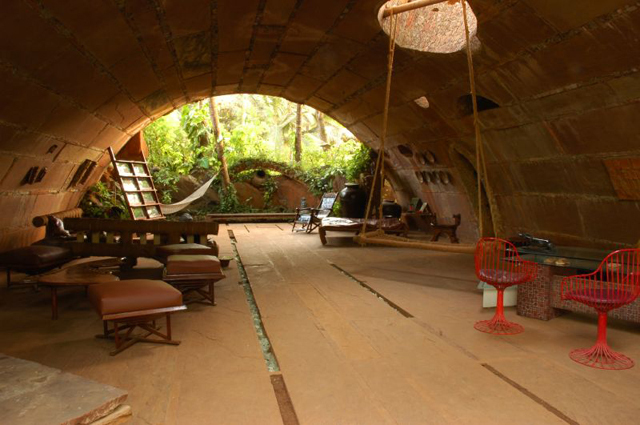
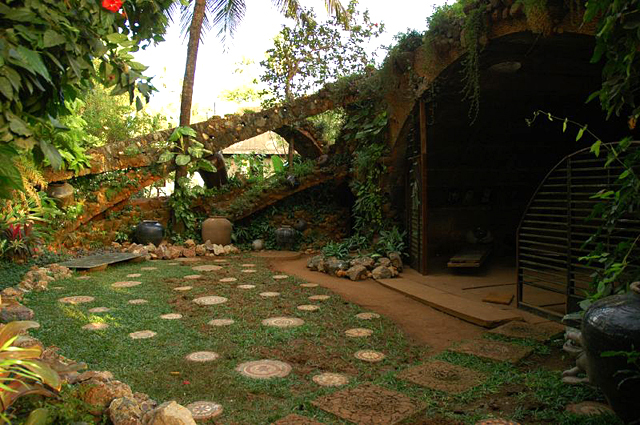
Jain Bungalow, Lonavala
Nari Gandhi’s project, the Jain Bungalow in Lonavala, is another notable architectural endeavour that reflects his distinctive design approach and sensitivity to the natural environment. Located in the picturesque hill station of Lonavala, Maharashtra, this residential project exemplifies Gandhi’s commitment to responding to the specific context of the site.
The Jain Bungalow is situated amidst the lush greenery and serene surroundings of Lonavala, offering a tranquil retreat from the hustle and bustle of urban life. Gandhi’s design for the bungalow seeks to harmonize with the natural landscape, integrating seamlessly into its hillside setting.
One of the defining features of the Jain Bungalow is its thoughtful layout, which takes full advantage of the panoramic views of the surrounding hills and valleys. Large windows and outdoor living spaces are strategically positioned to capture these views while creating a strong connection between the interior and exterior spaces.
The house is located on a sloping site and the design of the house nestled it in the heart of terraced gardens. Right from the site boundary, which was at a much higher level than the entry of the house, Nari Gandhi built up receding terraces that hosted a variety of local plants and trees.
The structure consisted of stone masonry walls deploying varying sizes and colours of igneous rocks from the Western Ghats, and steel trusses and struts. Inner courtyards are embellished with small chips of stones. The house followed a stepped profile throughout with a single roof plane, having dormer windows that unified the distinct rooms. Existing trees on the site also dictated the special arrangement of the house. Overall, the house follows the profile of the slope, and the roof resonates with the incline of the mountains in the backdrop.

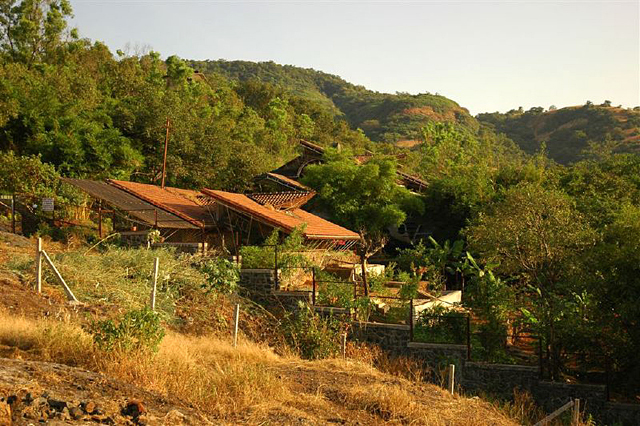

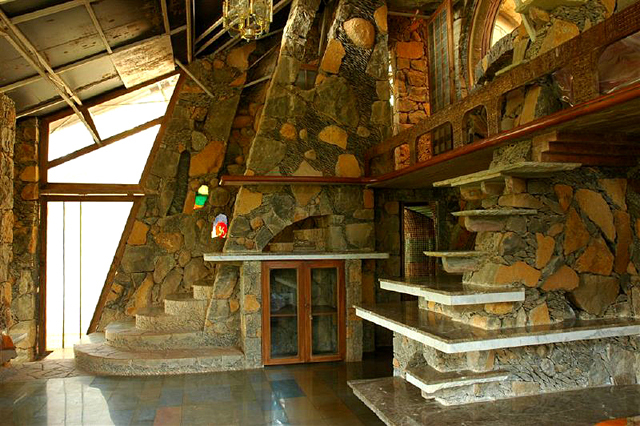

Jal Gobhai’s Mountain Lodge, Lonavala
Jal Gobhai’s Mountain Lodge in Lonavala is another notable architectural project designed by Nari Gandhi. Situated near the Tungarli dam in the scenic hill station of Lonavala, Maharashtra, this residential lodge exemplifies Gandhi’s innovative design approach and his sensitivity to the natural environment.
The Mountain Lodge is nestled amidst the lush greenery and rugged terrain of Lonavala’s hills, offering its occupants a serene and picturesque retreat. Gandhi’s design for the lodge is characterized by its seamless integration with the surrounding landscape, creating a harmonious relationship between built form and nature.
This Mountain Lodge is a simple weekend house for the Gobhai family. It is situated on a cliff in a remote location near an elevated dam reservoir, barely accessible by a heavy vehicle. The building is a stone masonry structure built in the ‘desert masonry’ method that Frank Lloyd Wright developed for Taliesin West. Stones are placed between wooden formwork with flat sides facing outwards and concrete is poured from the top. After the concrete is allowed to be set, the formwork is removed, and the effect is that of large stones set in rough concrete.
Trusses for the lodge are in wood and roofing is in asbestos-cement sheets. The roof is very expressive with long projections at the gable and eaves that touch the ground. Deep verandas have been provided on all sides to protect the house from rain.



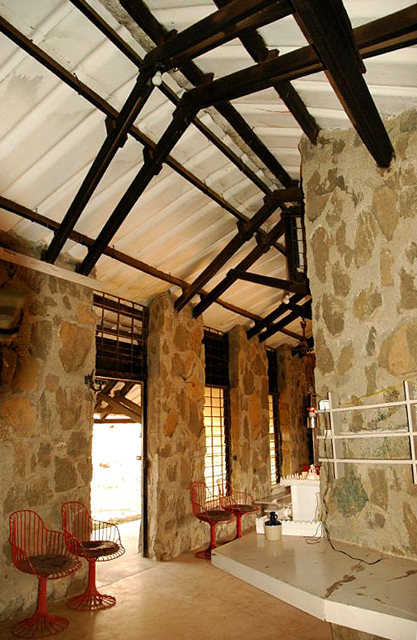
Sadruddin Daya’s Revdanda Residence
Nari Gandhi’s project, Sadruddin Daya’s Revdanda Residence in Revdanda, Maharashtra, is a significant architectural endeavour that showcases his innovative design approach and sensitivity to the local context. Revdanda is a coastal town in Maharashtra, known for its serene beaches and historical significance.
The vernacular architecture of the surrounding villages echoed in the deep roof overhangs, spacious verandas, clear stories to allow ventilation and simple brick and mud construction. Externally the house is finished in the vernacular technique of ‘geru’ paint.
The house is placed in the heart of a dense betel nut and coconut plantation. A meticulously landscaped garden is the highlight of this house. Nari Gandhi used locally made pots filled with cement and inverted them into a bed of plain cement concrete. These pots were arranged in a concentric pattern and different sizes, so the result was a dramatic ‘ripple’ of inverted pots in the heart of the plantation.
This residence is a testament to Nari Gandhi’s architectural vision and design philosophy. By embracing the natural beauty of the site and integrating it into the design, Gandhi has created a residence that celebrates the harmony between the built form and the surrounding landscape, providing a serene and rejuvenating retreat for its occupants.
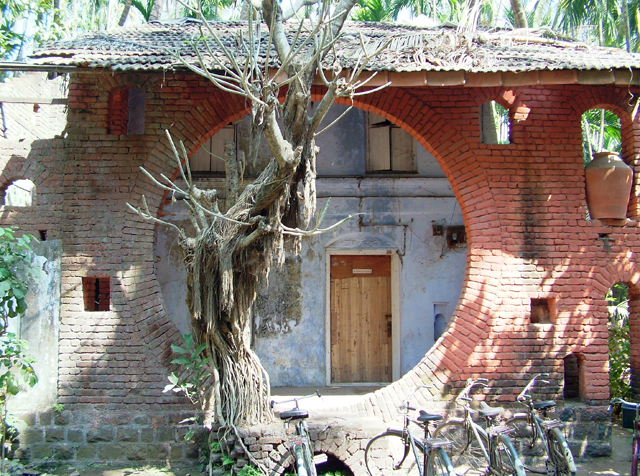

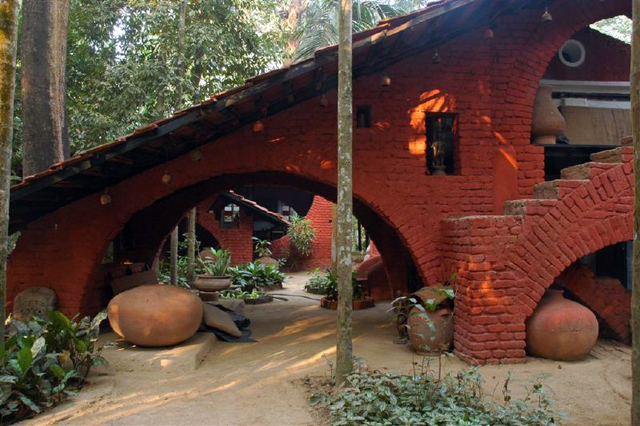


Influence on Contemporary Indian Architecture
Nari Gandhi’s architecture has greatly influenced modern Indian architecture in several ways. He emphasized organic architecture that blends buildings with nature. Many modern architects in India try to create eco-friendly buildings using sustainable design and natural materials.
He incorporated traditional Indian architectural elements into his designs. This has inspired today’s architects to embrace India’s rich heritage while meeting modern needs. They draw inspiration from traditional techniques, materials, and cultural motifs.
Gandhi was willing to experiment with new forms, materials, and construction methods. This encourages contemporary Indian architects to push boundaries and explore innovative solutions using cutting-edge technology.
His focus on sustainable, environment-friendly architecture has deeply impacted modern Indian architecture. Today’s architects prioritize energy efficiency, green building practices, and minimizing environmental impact.
Gandhi aimed to create buildings focusing on human well-being and comfort. This has influenced architects today to take a human-centred approach emphasizing user experience, accessibility, and enhancing quality of life.
Gandhi’s architecture continues to inspire and shape Indian architecture today regarding design, sustainability, and cultural identity.
A Tribute
Sadly, Nari Gandhi’s promising career ended when he died in a car accident in 1993 at age 59 while visiting a project site. With love and gratitude, we honour Nari Gandhi, a visionary architect whose legacy influences Indian architecture.
Gandhi was a trailblazer, innovator, and artist whose creations transcended mere buildings to become timeless art. His pioneering approach blended modernist and traditional Indian influences, leaving an indelible mark.
Long before it was popular, he advocated sustainability, using natural materials, sustainable practices, and designs sensitive to the local context and human needs.
Beyond architecture, Gandhi mentored and inspired countless aspiring architects to embrace creativity, innovation, and excellence.
As we reflect, we honour not just his architectural achievements but the profound impact he had on those who knew him. His spirit lives through his buildings, teachings, and the lives he touched.
Today, we honour Nari Gandhi’s memory with respect, gratitude, and admiration. May his pioneering vision and beautiful creations continue inspiring us in architecture’s ever-evolving world.




One Response
It was great to re- live the works of this great Architect.
I understand that his works are open to the public sometime in the year. Can I know when such an event is planned. Would love to once again see the places that we can never even dream of designing.
Regards.
Architect Sanjay Kulkarni.
9371007634